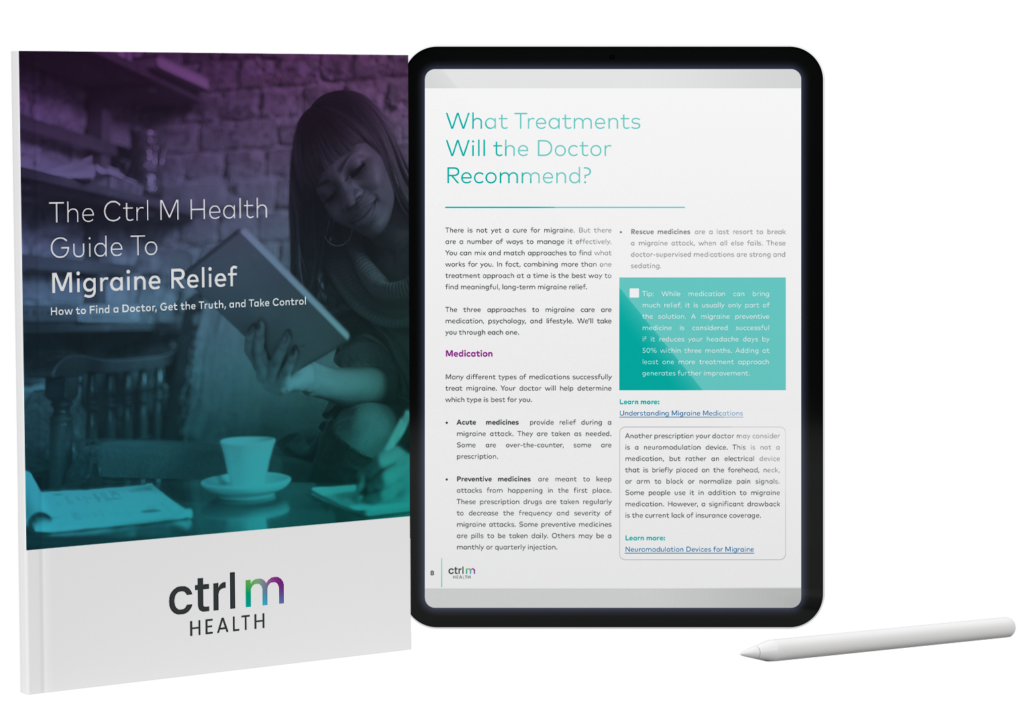Triggers is the hot topic of migraine. If you’ve ever had a headache, you’ve surely been asked what “triggered” it: red wine, soft cheese, loud music, perfume? Tons of well-meaning books, articles and even doctors say that the best way to reduce headaches is to track and avoid their triggers. It leads eager patients to keep detailed headache journals, follow tricky diets or avoid activities they otherwise enjoy — a worthwhile sacrifice, people figure, if it brings relief.
The problem? Most of what we’ve all been told about triggers is wrong.
The truth is, there’s rarely a straight line of cause and effect between a single trigger and migraine. Some commonly accepted “triggers” aren’t even triggers at all. And altogether there’s no evidence that trigger-avoidance strategies improve migraine. In fact, overemphasis on triggers may increase a patient’s anxiety and self-blame, actually making you feel worse.
Here, we bust some myths and uncover helpful facts.
Warning Signs
A migraine trigger is an ordinary event that has no effect on people without migraine, but is like Kryptonite (or dynamite) for the migraine brain. There’s no easy explanation yet for how triggers work, except that migraine brains are very sensitive to fluctuations. Also, each migraine brain is like a snowflake — no two react to a trigger exactly alike.
However, not everything that precedes a migraine is a trigger. Some of the most commonly cited “triggers” are most likely your body’s warning signs that a migraine is already on its way. These are called “premonitory” symptoms, and include neck pain; mood changes; food cravings; fatigue; and sensitivity to light, sounds, and odors. Mind you, all of these are very real things that happen to your body! They just aren’t necessarily the cause of your migraine — they’re your body’s distress signal, alerting you to danger.
Does chocolate cause migraines? you ask. Patients rank chocolate number one of all food-based triggers, but studies have found zero evidence to support that it’s a trigger at all. In fact, a chocolate craving might be the body’s way of self-soothing in the face of migraine, since chocolate not only improves mood, it contains magnesium and riboflavin, both thought to help prevent migraine. The same can be said for caffeine, an oft-cited “trigger” that actually helps acute headache.
Proven Migraine Triggers
So what is a true migraine trigger? Clinical studies have verified these:
-
- Fasting. Going for a long stretch of time without food is a reliable migraine trigger, proven in lots of studies, including those of fasting for religious reasons like Ramadan or Yom Kippur. Water deprivation is also a likely migraine trigger.
- Premenstrual periods in women. The biologically normal hormone fluctuations of menstruation can trigger the brain into having an overreaction.
- The post-stress “let down.” Did you know the most popular day for migraine is Saturday? It’s thought that after a sustained period of stress, the body’s autonomic changes when you finally relax become a migraine trigger.
- Low barometric pressure. High altitude is a proven trigger, especially during rapid ascents.
Trigger Management Strategy
Start by accepting that migraines probably occur somewhat arbitrarily, meaning they’re not reliably brought on by most triggers. Let’s also work to accept that some triggers are basically unavoidable — you can’t stop the weather, and you can only do so much about weekday stress, or hormonal changes in your body.
Here’s why that knowledge and acceptance is a good thing: Because you can drive yourself half-crazy avoiding triggers and not making progress. Or you can devote that energy to doing the things we know work to build up your resistance to migraine:
-
- Make healthy lifestyle choices. Maintaining a healthy weight, good sleep hygiene, regular exercise, and stress management are all protective factors against migraine.
- Resist fear. The fear of having migraine between attacks is called “cephalgiaphobia,” and having it makes you much more migraine-prone. If you find yourself worrying about migraine when you don’t have one, or restrict your activities due to fear of migraine, it’s important to address this fear and put in its place. Cognitive behavioral therapy and biofeedback are both good tactics.
- Explore prevention medications. These medicines are meant to keep your headaches from occurring in the first place. Talk to your doctor about whether one may be right for you.
Remember, because migraine is unpredictable by nature, no strategy is foolproof. But by paying attention to these factors, you’ll increase your migraine threshold, bit by bit, building your capacity to move through life with more freedom. And no more chasing your tail with trigger tracking!
The Care Tuner Guide to Migraine Relief
Untreated migraine tends to worsen over time, so if you suspect you have migraine, it’s important to get help. We’ve compiled everything you need, including what to expect, pitfalls to avoid, and what you can do right now to get relief.

Get some helpful trigger management strategies from this article? Learn how to put one of them to use with “The 4-Step Guide to Movement for Migraine.”





